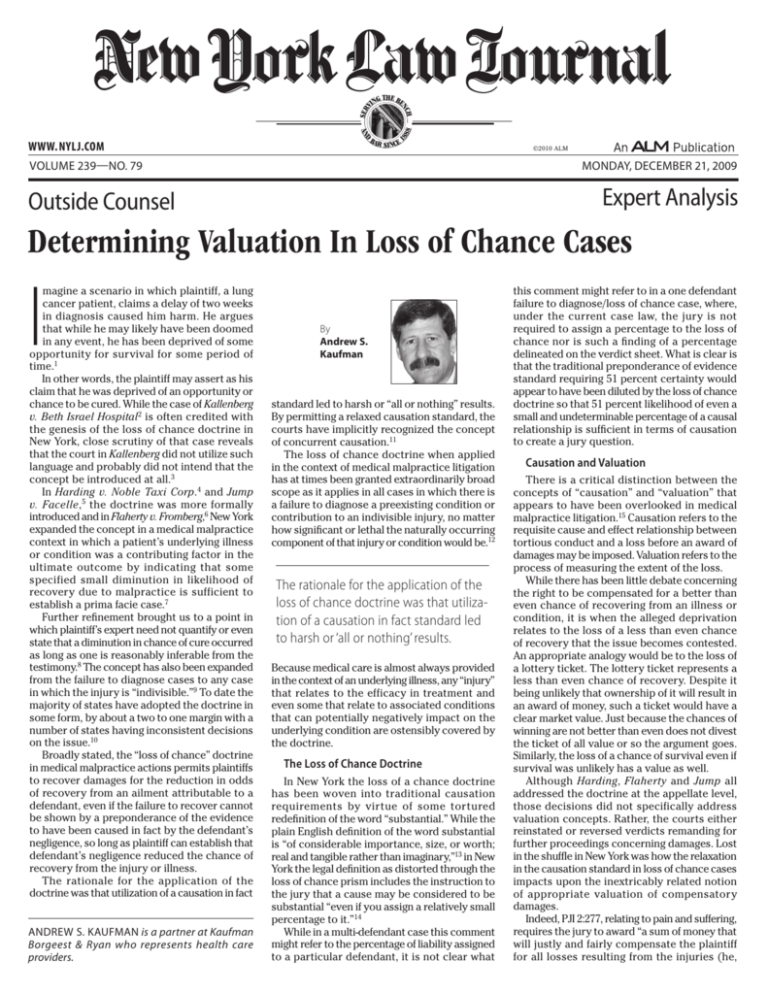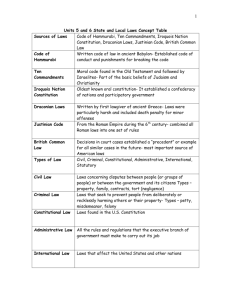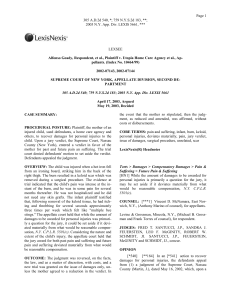
88
8
SER
V
H
NC
AND
www. NYLJ.com
THE BE
ING
1
BA
R SINCE
©2010 ALM
monday, december 21, 2009
Volume 239—NO. 79
Expert Analysis
Outside Counsel
Determining Valuation In Loss of Chance Cases
I
magine a scenario in which plaintiff, a lung
cancer patient, claims a delay of two weeks
in diagnosis caused him harm. He argues
that while he may likely have been doomed
in any event, he has been deprived of some
opportunity for survival for some period of
time.1 In other words, the plaintiff may assert as his
claim that he was deprived of an opportunity or
chance to be cured. While the case of Kallenberg
v. Beth Israel Hospital2 is often credited with
the genesis of the loss of chance doctrine in
New York, close scrutiny of that case reveals
that the court in Kallenberg did not utilize such
language and probably did not intend that the
concept be introduced at all.3
In Harding v. Noble Taxi Corp.4 and Jump
v. Facelle,5 the doctrine was more formally
introduced and in Flaherty v. Fromberg,6 New York
expanded the concept in a medical malpractice
context in which a patient’s underlying illness
or condition was a contributing factor in the
ultimate outcome by indicating that some
specified small diminution in likelihood of
recovery due to malpractice is sufficient to
establish a prima facie case.7
Further refinement brought us to a point in
which plaintiff’s expert need not quantify or even
state that a diminution in chance of cure occurred
as long as one is reasonably inferable from the
testimony.8 The concept has also been expanded
from the failure to diagnose cases to any case
in which the injury is “indivisible.”9 To date the
majority of states have adopted the doctrine in
some form, by about a two to one margin with a
number of states having inconsistent decisions
on the issue.10
Broadly stated, the “loss of chance” doctrine
in medical malpractice actions permits plaintiffs
to recover damages for the reduction in odds
of recovery from an ailment attributable to a
defendant, even if the failure to recover cannot
be shown by a preponderance of the evidence
to have been caused in fact by the defendant’s
negligence, so long as plaintiff can establish that
defendant’s negligence reduced the chance of
recovery from the injury or illness.
The rationale for the application of the
doctrine was that utilization of a causation in fact
Andrew S. Kaufman is a partner at Kaufman
Borgeest & Ryan who represents health care
providers.
By
Andrew S.
Kaufman
standard led to harsh or “all or nothing” results.
By permitting a relaxed causation standard, the
courts have implicitly recognized the concept
of concurrent causation.11
The loss of chance doctrine when applied
in the context of medical malpractice litigation
has at times been granted extraordinarily broad
scope as it applies in all cases in which there is
a failure to diagnose a preexisting condition or
contribution to an indivisible injury, no matter
how significant or lethal the naturally occurring
component of that injury or condition would be.12
The rationale for the application of the
loss of chance doctrine was that utilization of a causation in fact standard led
to harsh or ‘all or nothing’ results.
Because medical care is almost always provided
in the context of an underlying illness, any “injury”
that relates to the efficacy in treatment and
even some that relate to associated conditions
that can potentially negatively impact on the
underlying condition are ostensibly covered by
the doctrine.
The Loss of Chance Doctrine
In New York the loss of a chance doctrine
has been woven into traditional causation
requirements by virtue of some tortured
redefinition of the word “substantial.” While the
plain English definition of the word substantial
is “of considerable importance, size, or worth;
real and tangible rather than imaginary,”13 in New
York the legal definition as distorted through the
loss of chance prism includes the instruction to
the jury that a cause may be considered to be
substantial “even if you assign a relatively small
percentage to it.”14
While in a multi-defendant case this comment
might refer to the percentage of liability assigned
to a particular defendant, it is not clear what
this comment might refer to in a one defendant
failure to diagnose/loss of chance case, where,
under the current case law, the jury is not
required to assign a percentage to the loss of
chance nor is such a finding of a percentage
delineated on the verdict sheet. What is clear is
that the traditional preponderance of evidence
standard requiring 51 percent certainty would
appear to have been diluted by the loss of chance
doctrine so that 51 percent likelihood of even a
small and undeterminable percentage of a causal
relationship is sufficient in terms of causation
to create a jury question.
Causation and Valuation
There is a critical distinction between the
concepts of “causation” and “valuation” that
appears to have been overlooked in medical
malpractice litigation.15 Causation refers to the
requisite cause and effect relationship between
tortious conduct and a loss before an award of
damages may be imposed. Valuation refers to the
process of measuring the extent of the loss.
While there has been little debate concerning
the right to be compensated for a better than
even chance of recovering from an illness or
condition, it is when the alleged deprivation
relates to the loss of a less than even chance
of recovery that the issue becomes contested.
An appropriate analogy would be to the loss of
a lottery ticket. The lottery ticket represents a
less than even chance of recovery. Despite it
being unlikely that ownership of it will result in
an award of money, such a ticket would have a
clear market value. Just because the chances of
winning are not better than even does not divest
the ticket of all value or so the argument goes.
Similarly, the loss of a chance of survival even if
survival was unlikely has a value as well.
Although Harding, Flaherty and Jump all
addressed the doctrine at the appellate level,
those decisions did not specifically address
valuation concepts. Rather, the courts either
reinstated or reversed verdicts remanding for
further proceedings concerning damages. Lost
in the shuffle in New York was how the relaxation
in the causation standard in loss of chance cases
impacts upon the inextricably related notion
of appropriate valuation of compensatory
damages.
Indeed, PJI 2:277, relating to pain and suffering,
requires the jury to award “a sum of money that
will justly and fairly compensate the plaintiff
for all losses resulting from the injuries (he,
monday, december 21, 2009
she) sustained.” The trial and appellate courts
have inconsistently addressed how the loss
of chance doctrine should be considered by a
jury in terms of valuation and there does not
appear to be any appellate case in which loss
of chance issues have been included as part of
a specific interrogatory on the verdict sheet, so
that discounting of the verdict for the pre-existing
illness can take place.
With the exception of an interrogatory
requesting the number of years over which the
award is applicable, the verdict sheet in New
York makes no reference to any loss of chance
elements necessary to perform the appropriate
valuation. While there are a smattering of
appellate division cases16 that make oblique
reference to discounting by virtue of the
underlying illness in addressing the extent of
damages, there is but one lone trial level decision
in which a court appears to have addressed the
valuation issue head on.17 In that case the court
determined the loss of chance and discounted
the verdict accordingly because the issue had
not been raised appropriately prior to verdict.18
In New York the loss of chance charge19 explicitly
encourages the jury to relax the causation
standard, but the lack of any reference in the
damages charge implicitly encourages the jury
not to consider the concept of loss of chance
when evaluating the extent of damages.
A Proposal
The general rationale put forth for the
doctrine is that traditional causation concepts
are unfairly limiting and that patients who are
victims of inappropriate care, for whom the
underlying disease rather than the care was the
predominant factor in their injury or demise,
should nevertheless have a right to have their
grievances aired and be compensated. While this
argument has some merit, it fails to recognize
that any position on this issue should be the
result of a balancing of social policies in this
case, the best approach to spreading of the
risk of such “injuries” and that of policing the
medical profession.
Given the recent focus on the increasing cost
of health care and vigilance of the Department
of Health and Office of Professional Discipline in
policing the profession it would seem that such
a relaxation of the causation standard would
no longer be necessary, particularly since it
was one that originally sprouted from judicial
fiat rather than legislative enactment. Indeed,
the causation standard for other professionals
in New York such as real estate brokers and
engineers are much more exacting, while those
professions appear to be less under siege than
the medical profession.
As an alternative to the abolition of the loss of
chance doctrine in New York and the hardship
that might result from an all or nothing system
of causation, more prominent and consistent
application of the valuation concept to the
damage elements of a verdict would be an
appropriate and viable alternative approach.
Many courts that have recognized chance
as a compensable interest, including those
in New York, have allowed the trier of fact to
value that chance without offering meaningful
guidance on how to do so. While this approach
has the advantage of simplicity, if an important
reason for compensating the loss of a chance
is to achieve a more accurate loss allocation,
a more predictable and finely tuned method of
valuation is preferable.20
In New Jersey an unusual device is utilized
based on a case called Scafidi v. Seiler21 and its
progeny in which the plaintiff has the burden of
proof on causation issues, but once satisfied the
burden of proof on valuation or probability issues
shifts to the defendant. It is the court however
that discounts the verdict based on the extent
of the contribution of the preexisting condition.
While this approach does address the lack of
discount of the verdict based on the underlying
disease, it inexplicably takes the performance of
this task out of the hands of the trier of fact.
A more appropriate method of valuation
and one utilized by the courts in Oklahoma
and Kansas22 would permit the question of
proximate cause to go to the jury absent any
expert testimony concerning statistical decrease
in the likelihood of cure or survival, but places
the burden on the plaintiff to introduce statistical
evidence on the issue of damages so a jury can
Many courts that have recognized
chance as a compensable interest,
including those in New York, have
allowed the trier of fact to value that
chance without offering meaningful
guidance on how to do so.
be provided with some guidance concerning
the extent of damages.
The jury determines the chance of survival
given the underlying illness in the absence
of negligence, the percentage of diminution
in the chance resulting from the defendant’s
negligence, and the total measure of damages.
The trial court then multiplies the total amount
of damages by the net reduced figure to
determine the final award.
To illustrate, assume that the jury found that
the patient originally had a 40 percent chance of
cure and that the physician’s negligence reduced
the chance of cure to 25 percent and that the
total damages proved were $1 million. The
court would then perform the mathematics and
subtract 25 percent from 40 percent to arrive at
15 percent, which represents the loss of chance.
It would then multiply that percentage by the
total loss to arrive at $150,000, the value of
damages actually caused by the defendant.23
The above approach would resolve some
of the confusion under New York’s current
system and remedy some of the omissions of
the current PJI damages charges in cases in
which plaintiff has requested a loss of chance
charge on causation. Moreover, an additional
charge including a reference to the loss of
chance language indicating that while the law
permits an award of damages based on the loss
of chance of cure or survival (as the case may
be) would be appropriate.
Conclusion
New York has been progressive in adopting
the loss of chance rather than an all or nothing
approach to causation, but in doing so has not
consistently and appropriately recognized the
concomitant concept of valuation of injury. Its
jury instructions, verdict sheet and appellate
decisions24 have not appropriately incorporated
valuation concepts into the charge and verdict
sheet. The courts have converted a traditional
all or nothing approach that penalized the
plaintiff by requiring too demanding a causal
connection to one in which the defendant is
penalized and the plaintiff receives a windfall.
The above proposal represents an appropriate
and viable approach to the valuation of damages
in loss of chance cases.
••••••••••••••••
•••••••••••••
1. This was essentially the fact pattern in Hughes v. New
York Hospital, 195 A.D.2d 442, 600 N.Y.S.2d 145 (2nd Dept.
1993).
2. 45 A.D.2d 177, 357 N.Y.S.2d 508 (1st Dept. 1974), aff’d 37
N.Y.2d 719 (1975).
3. See Dan Kramer, Medical Malpractice: Proximate Cause
Analysis, NYLJ, Volume 239, Feb. 6, 2008. Prior to 1992, when
Harding v. Noble Taxi Corp., 182 A.D.2d 365, 582 N.Y.S.2d 1003
(1st Dept), was decided, a number of cases including Kimball
v. Scors, 59 A.D.2d 984, 399 N.Y.S.2d 350 (3rd Dept. 1977),
appeal denied 43 N.Y.2d 648 (1978); Monahan v. Weichert, 82
A.D.2d 102, 442 N.Y.S.2d 295 (4th Dept. 1981); Mortensen v.
Goldstein, 105 A.D.2d 151, 483 N.Y.S.2d 264 (1st Dept. 1984);
and Mertsaris v. 73rd Corp., 105 A.D.2d 67, 482 N.Y.S.2d 792
(2nd Dept. 1984) defined causation as more likely than not.
4. 182 A.D.2d 365, 582 N.Y.S.2d 1003 (1st Dept. 1992).
5. 275 A.D.2d 345, 712 N.Y.S.2d 162 (2000).
6. 46 A.D.3d 743, 849 N.Y.S.2d 278 (2nd Dept. 2007). See
Dan Kramer, Medical Malpractice: Proximate Cause Analysis,
NYLJ, Volume 239, Feb. 6, 2008 (on the genesis of the loss of
chance doctrine).
7. See Harding v. Noble Taxi Corp., 182 A.D.2d 365, 582
N.Y.S.2d 1003 (1st Dept. 1992) (plaintiff’s expert testified
that had the plaintiff received timely, proper treatment, 80
percent of her injuries could have been prevented).
8. Hughes v. New York Hospital, 195 A.D.2d 442, 600
N.Y.S.2d 145 (2nd Dept. 1993).
9. Joseph H. King Jr., Causation, Valuation and Chance in
Personal Injury Torts Involving Preexisting Conditions and
Future Consequences, 90 Yale L.J. 1353 (1981).
10. See Crosby v. United States, 48 F.Supp.2d 924, (U.S. Dist.
Ct., Alaska, 1999) (for the run down of states having adopted
the doctrine). Crosby was decided in 1999, but the trend
seems to be in the direction of adoption of the doctrine.
11. N.Y. PJI 2:70.
12. See supra note 9.
13. “substantial, a.” OED Online. 2009 Oxford University
Press. 5 Oct. 2009 <http://www.askoxford.com/concise_oed/
substantial?view=uk>.
14. N.Y. PJI 2:70. See also Crosby v. United States, 48
F.Supp.2d 924, (U.S. Dist. Ct., Alaska, 1999).
15. See supra note 9.
16. See e.g. Forrester v. Zwanger-Pesiri Radiology Group,
274 A.D.2d 374, 710 N.Y.S.2d 620 (2d Dept. 2000); Schneider v.
Memorial Hospital fro Cancer and Allied Diseases, 100 A.D.2d
583, 473 N.Y.S. 524 (2d Dept. 1984)
17. Birbeck v. Central Brooklyn Medical Group, 2001 WL
1154985 (N.Y. Sup 2001). Note that the Court mistakenly
compared the 70 percent cure rate with an earlier diagnosis
to a 0 percent cure rate because the patient died, rather than
compare the cure rate with an earlier diagnosis to the cure
rate with a later diagnosis irrespective of actual outcome.
18. Id.
19. See comment to PJI 2:150
20. See supra note 12 at 14.
21. 119 N.J. 93, 574 A.2d 398 (1990).
22. See McKellips v. Saint Francis Hospital Inc., 741 P.2d
467 (Oklahoma, 1987) and Jorgensen v. Vener, 616 N.W.2d 366
(2000).
23.A pattern verdict sheet is included in Jorgensen, supra
note 22
24. Harding v. Noble Taxi Corp., 182 A.D.2d 365, 582
N.Y.S.2d 1003 (1st Dept. 1992); Flaherty v. Fromberg, 2007 N.Y.
App. Div. Lexis 12847 (2nd Dept. 2007); and Jump v. Facelle,
275 A.D.2d 345, 712 N.Y.S.2d 162 (2000).
Reprinted with permission from the December 21,
2009 edition of the NEW YORK LAW JOURNAL ©
2009. ALM Media Properties, LLC. All rights reserved.
Further duplication without permission is prohibited.
For information, contact 877-257-3382 or reprints@
alm.com. # 070-03-11-43









